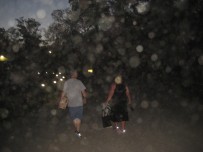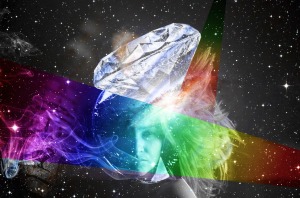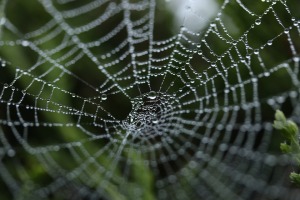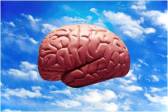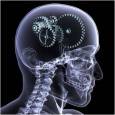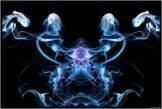
An “image” for consciousness?
On April 13th 2018 I wrote a post here titled “Deep and Deeper,” after speaking at the annual Seminar for IEA’s Caroline D. Bradley Scholarship students. The theme of that year’s seminar was Intersections. In that post I wrote: “…the new depths that interest me may not appeal to everyone. The title of my CDB workshop [ “From Indra’s Net to the Internet: Intersections, Reality and Consciousness.”] refers to both the mystical image of Indra’s net and the material world reality of the internet, two very different ways of perceiving intersections, the connectedness of all things. What I will be doing here in future is exploring both kinds of “deep.”
That’s what I’m doing again today. During the first week of July I had the honor and privilege of giving several presentations at PGR, the multi-day Colorado retreat for families of profoundly gifted kids. It was held at Glen Eyrie Castle, a conference center adjacent to Garden of the Gods, National Natural Landmark in Colorado Springs.
My two main presentations at PGR this month were focused on “both kinds of deep.” The first, Intelligence: Intellect and Intuition dealt with intellect as the fairly standard definition of intelligence and went deeper into the mostly (or at least often) overlooked but vastly important intuitive aspect. The other, Science and Consciousness, focused on two subjects that have long both interested and frustrated me. The frustration comes from the difficulty many scientists have finding a way to account for the relationship between these two. Science (materialist science) as a discipline is a creation of the human mind, yet consciousness—or mind itself—remains one of its greatest puzzles—the “hard problem” as it is often called. It is a hard problem because mind is manifestly immaterial. And that leaves materialist scientists with the curiously unsatisfying explanation that mind is a more or less “accidental” byproduct of the chemical and electrical functions of the brain. (But mind—of course—is what got me into the whole realm of the highly gifted in the first place!)
 It is clear that mind and brain are intimately connected. Obviously, when the brain is damaged or malfunctions, or hasn’t fully formed during development, or is altered by drugs or chemicals, the individual’s mind does not function normally. But to assume that because of the need for a working brain to allow an individual to exhibit normal mental processing means that the brain is somehow manufacturing that mind is a bit like assuming that a working physical computer manufactures the messages in your email account or on your social networking sites. True that the brain is a living system while a computer is a mechanical/electronic one, but one still needs a way to account for the origins of the information that living system processes.
It is clear that mind and brain are intimately connected. Obviously, when the brain is damaged or malfunctions, or hasn’t fully formed during development, or is altered by drugs or chemicals, the individual’s mind does not function normally. But to assume that because of the need for a working brain to allow an individual to exhibit normal mental processing means that the brain is somehow manufacturing that mind is a bit like assuming that a working physical computer manufactures the messages in your email account or on your social networking sites. True that the brain is a living system while a computer is a mechanical/electronic one, but one still needs a way to account for the origins of the information that living system processes.
Actually, if one looks for scientific evidence that the brain does not create consciousness (awareness, thoughts, ideas, dreams, fantasies) it isn’t impossible to find. One does, of course, have to actually go looking for it. As Eben Alexander, the neurosurgeon whose brain was devastated by a raging infection that put him in a deep coma (from which no medical experts expected him to awake at all, let alone without severe neurological impairment), writes, he had dismissed the idea that mind could exist without a functioning brain because—without investigating—he had, as a medical doctor, “known” that it couldn’t be true. The idea that his own consciousness could experience and then later remember those experiences he had while the machines in his hospital room were showing his neocortex essentially nonfunctional–“offline”–went against all his medical training, training that he would have called “truth” rather than “belief.” His experience, however, annihilated his previous belief system. Once he began to research new science he had never known existed, he discovered that his previous certainties about the relationship between mind and brain were part of a scientific belief system so pervasive that relatively few doctors question it.
Perhaps because I’m a writer highly dependent on imagination (an aspect of mind that’s also difficult to define scienti fically), I know that it’s possible to create with words entire worlds and characters that a reader can “feel” as she reads to be somehow real, though made entirely of thought that can be shared by many other minds. So I have an overwhelming respect for human consciousness that includes both thought and imagination. And in a way, the fact that a person’s belief system can be so strong that it can dismiss any amount of external or written evidence that contradicts it, gives us a clue to the power of mind not just to gain new information, but also to reject it utterly. We writers have to pay attention to the need for our readers to sometimes “suspend disbelief” in order to stay with our story. And that can be tricky sometimes. “Seeing is believing” is a common saying. “Believing is seeing” is probably more accurate.
fically), I know that it’s possible to create with words entire worlds and characters that a reader can “feel” as she reads to be somehow real, though made entirely of thought that can be shared by many other minds. So I have an overwhelming respect for human consciousness that includes both thought and imagination. And in a way, the fact that a person’s belief system can be so strong that it can dismiss any amount of external or written evidence that contradicts it, gives us a clue to the power of mind not just to gain new information, but also to reject it utterly. We writers have to pay attention to the need for our readers to sometimes “suspend disbelief” in order to stay with our story. And that can be tricky sometimes. “Seeing is believing” is a common saying. “Believing is seeing” is probably more accurate.
One doesn’t have to look far to find advocates of materialist science’s worldview who reject Dr. Alexander’s new view created by his own experience. But that experience has changed not only his way of life, but his whole definition of reality. Since his book was published many people have shared with him the way their own life experiences have shattered their old beliefs but have opened their own conscious awareness to more possibilities than they could ever have imagined, let alone believed. The world turns out to be full of people whose experiences, though unique to them, offer corroboration of his own.
Several PG teens who attended my talk about consciousness were, let’s say, “highly resistant” to its content. For a time I entertained their questions and objections to what I was presenting, but I had considerable information about the growing “science of consciousness,” that I had come to share with the people who had come to my session at least willing to consider it. I pointed out that I didn’t expect everyone to believe everything I was saying—my own ideas about these complex and challenging issues are based not only on my considerable readings in the field of consciousness, but also on my own lived experience.
After a while I had to give the kids the choice to stay in the session and listen, or to leave. Some left, some stayed. I don’t write about it here to criticize their behavior. They were super bright teens with their own strong belief in the mainstream, materialist science they had explored and learned about. And I was, after all, challenging some of the basic tenets of that science. It’s possible that one day one of them could bring new ideas, information or “interpretations” into science as it moves ever forward.
It has been said that science progresses “one death at a time.” People whose lives, careers and reputations have been built on ideas, explanations, “beliefs” that are being challenged by new information, may be utterly unable to relinquish their cherished assumptions. I talked a bit about Hugh Everett, whose “Many Worlds” interpretation (MWI) of quantum physics was originally almost universally rejected, and whose career in physics was basically halted by the scientists who couldn’t let go of their own beliefs. I pointed out that recently an astrophysicist on my local NPR station was discussing the difference between the “Copenhagen Interpretation” of quantum physics championed by Einstein, and Everett’s idea that every time one of two opposite outcomes might occur that both do and the worlds split. The shocked interviewer, clearly sure this was a totally crazy idea, asked how many “actual physicists” accept it. The answer given was that, in spite of overwhelming early dismissal, probably about fifty percent of physicists today agree with it. “And in some circles it would be 100%,” he added.
And here’s a synchronicity. A friend shared this quote with me today, just as I was about to write this post: “The day before something is truly a breakthrough, it’s a crazy idea.” — Peter Diamondis
Why do I want to write about this here on The Deep End? Because this blog is all about extreme intelligence in an ever-changing world. No matter how brilliant any individual is, even Einstein, who refused to believe in “spooky action at a distance” explained that it is curiosity and mystery that drive scientists to do their work. They wonder. They hypothesize. And sometimes they discover something that challenges even beliefs that have previously been accepted as truths. Whether we consider ourselves scientists or not, as we live our lives, our experiences may well take us into “other worlds” that we may have thought impossible based on what we were taught or learned to believe. And no, I can’t buy the idea that mind, consciousness, is nothing more than a byproduct of our physical brains. It is essentially mystery and is likely to remain intriguingly worth exploring.
My own imaginings and wonderings about what’s possible, and the answers I encounter as my life experiences change, have left more than sixty years of beliefs behind. I hope that none of the new ones I’ve developed (most immediately the concept that consciousness is the foundation of the universe itself) ever become so rock solid that they can’t change when my own life changes around them, or new and unexplored worlds open up. I hope for any readers here the same thing.
Meantime, yes–I have experienced what neurobotany suggests, that trees can communicate not only with other trees, but with humans. For indigenous peoples this is not a “new” idea, but a very old one. 

